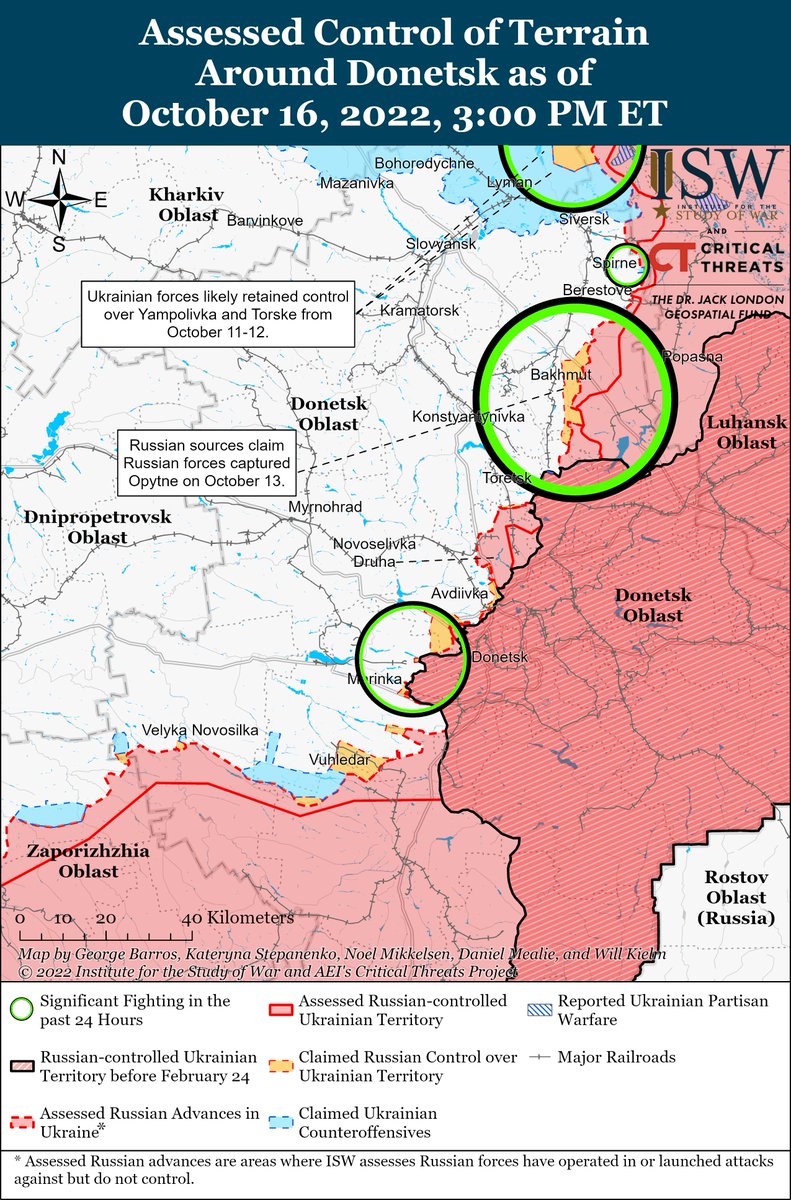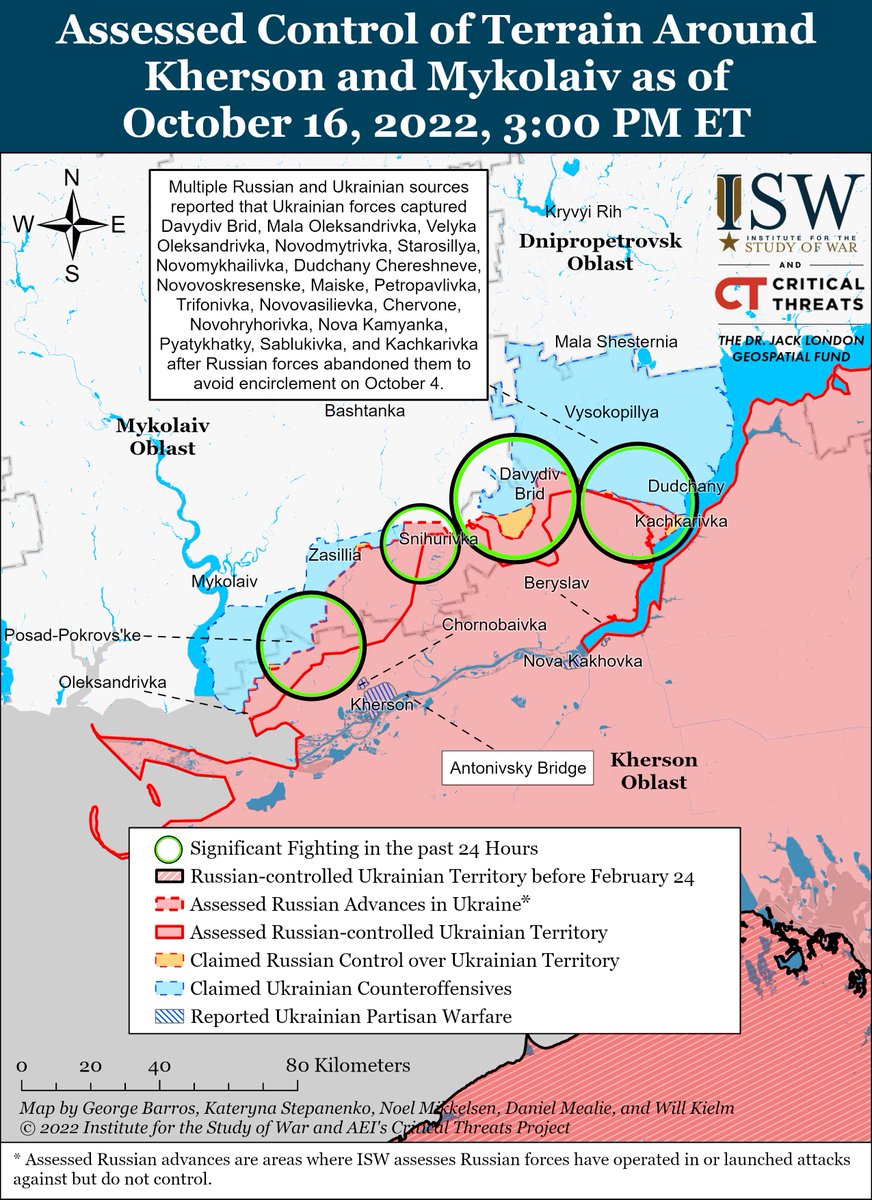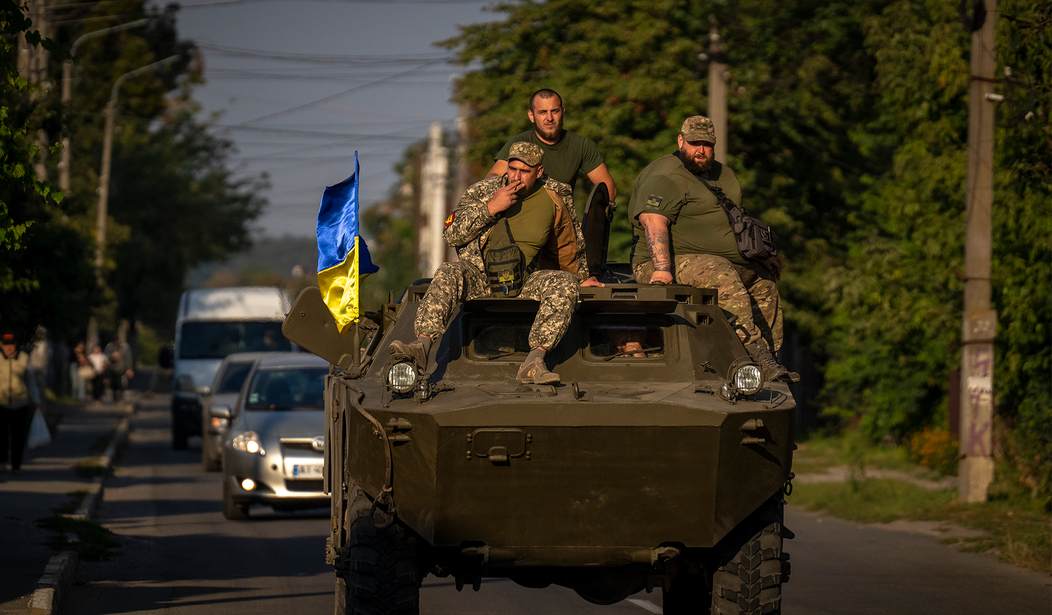As we contemplate Day 235 of Vladimir Putin’s triumphant prance towards Kiev, the ground war has been slowed a bit by the rasputitsa, or, to use vernacular from an older era, General Mud. This is not to say things aren’t happening; they are. They just aren’t necessarily kinetic…yet. So, to bring it up to date, since my Week 21 update (see Putin’s War, Week 31. Mobilization, Annexation, and Russian Forces Routed From New ‘Russian’ City), take a look at these posts.
Putin’s Illegal Annexation of Ukrainian Territory Marks the Beginning of a War Without a Perceivable End
Putin’s Ukraine Annexation Speech Told Us What to Expect From Russia, and It Is up to Us to Pay Attention
British Paper Warns That Russia’s Nukes Are on the Move and Putin May Be Planning to ‘Send a Signal’
Defense Department Announces Another $625 Million in Ukraine Aid, So Let’s Take a Look at DoD IG Report on Ukraine Spending So Far.
Elon Musk Denies He Talked to Vladimir Putin About His ‘Peace Plan,’ but the Whole Story Is a Lot More Murky
Russia’s Retaliatory Attacks on Ukrainian Civilian Targets Leave a Lot of Questions About Russian Capabilities
The big stories have been a) Russia’s “annexation” of four Ukrainian oblasts, b) Ukraine’s successful attack that shut down rail and road traffic on the Kerch Strait bridge, and c) Russia’s retaliatory strikes on Ukrainian cities.
Politico-Strategic Level
Russian Mobilization
Russian mobilization continues to be the main story. If Russia’s efforts to mobilize 300K “reservists” works and they enter the battle as effective soldiers, we’re looking at a Western-Front-in-1915 situation. But, on the other hand, if it doesn’t go well, Russia’s boast that it can mobilize 2-3 million men will look damned weak.
In my last update (see Putin’s War, Week 31. Mobilization, Annexation, and Russian Forces Routed From New ‘Russian’ City), I reported that the first mobilized men were captured in Ukraine just days after re-entering service. The initial phase of the operation was so botched that Putin addressed the issue in a speech. “We must correct mistakes and not allow them going forward,” he says, and everyone who doesn’t meet the criteria “must be sent home.” One former Russian general commented that alcoholism among newly mobilized soldiers was so pervasive that even other Russians had taken note.
Imagine being enough of an alkie that EVEN Russians are complaining about your alcoholism.
— streiff (@streiffredstate) October 16, 2022
I don’t know the exact location or date, but this was just too good not to include.
Dumb and dumber…#RussianArmy #StandWithUkraine️ #mobilization pic.twitter.com/CJczrcXl4F
— olexander scherba🇺🇦 (@olex_scherba) October 13, 2022
Videos continue circulating of police officers seizing men on the sidewalk and at subway stations. Sometimes there are spirited chases. There have been two incidents that, I believe, serve as metaphors for more significant problems for Russian mobilization.
The Russians have “misplaced” 1.5 million winter uniforms that were about to be send to the Russian soldiers in Ukraine. pic.twitter.com/zydL58OMXO
— Visegrád 24 (@visegrad24) October 2, 2022
The real question is not where they’ve gone but did they ever exist. Russian mobilization sites frequently lack uniforms, tents, field gear, or even toilets (see this Twitter thread). How much of this is due to a system that has never been exercised being caught short by a national crisis and how much is endemic corruption is anyone’s guess. The answer to that question will have an immense impact on how this war plays out.
The second story has an even greater impact than mere incompetence, graft, and corruption. It calls into question whether Russia can field a conscript army. The conscript units are lightly officered. This is a serious shortcoming as the Russian Army depends upon officers to train soldiers and small units. In Western armies, soldier and small unit training are largely the province of a long-serving (and perhaps long-suffering) corps of professional noncommissioned officers. Putin’s War has placed huge demands on the Russian officer corps. The number in the below tweet is a floor number. It is based on funerals and death announcements culled from Russian media and social media. The actual number will be significantly higher.
1 323 killed Russian officers as of 16 October.
Minimum confirmed losses. Confirmations are made via publicly available data from Russia, such as funeral notices, obituaries or news sites. pic.twitter.com/ogAk3EHvoa— Russian Officers killed in Ukraine 🇨🇿🇺🇦 (@KilledInUkraine) October 16, 2022
It is also no secret that a disproportionate number of Russian Army conscripts hail from Central Asia. With sparse supervision, “cross cultural communication,” as the DIE folks call it, can sometimes have unfortunate outcomes. Below is a Twitter thread from the historian Chris Owen, translated from Astra. All major media have run versions of this story.
Friendly Fire by streiff at redstate on Scribd
The body count is much less important than the events that led to it. All major media have run versions of this story. Is this shooting a one-off? Is it a Russian version of our own Fort Hood shooting or “Battle of Bamber Bridge?” Or is it a hint of things to come when semi-radicalized Muslim soldiers are mixed in units with non-Muslims where the level of supervision and discipline is de minimis?
UN Vote on Russian Annexation
The UN General Assembly voted on the legality of Russia’s annexation of four Ukrainian oblasts. Read Putin’s Illegal Annexation of Ukrainiavoted Marks the Beginning of a War Without a Perceivable End and Putin’s Ukraine Annexation Speech Told Us What to Expect From Russia and It Is up to Us to Pay Attention.
Unsurprisingly, many of the abstentions are from Russian arms customers, but, interestingly, there are a number of other Russian arms customers who voted to condemn the illegal annexations, including Myanmar, Egypt, Iraq, UAE, and Serbia. https://t.co/ItYJM1CPl9
— Rob Lee (@RALee85) October 12, 2022
The vote to annex Crimea received 11 votes; this annexation received only five. Even by the standard of bullsh** referendums, this was a failure.
While of little consequence now, it will have weight should this war rea; this stage of negotiations. The universal recognition of the illegality of the “referendums” will make it hard for Russia to make any legitimate claim to those territories.
Meduza reports that Putin is ready to talk but “Crimea is not to be mentioned”, “annexed territories in Donbas to stay in Russia”.
Russia may withdraw from Kherson area.
Smells like Minsk III that would allow Putin to better train and equip mobilized thousands of Russians— Anton Barbashin (@ABarbashin) October 14, 2022
More Prisoner Swaps
Another prisoner exchange took place today.
Ukraine managed to return 32 Warriors and bring back the body of Dmytro Fialka from Israel.
Many of these people were considered missing and went through hell.
Now they will get physical and mental rehabilitation.
📸: Andrii Yermak pic.twitter.com/PoiK2bJFyx
— Anton Gerashchenko (@Gerashchenko_en) October 11, 2022
Strong, and never broken.
Heroyam slava 🇺🇦✊ https://t.co/URplpoXbue pic.twitter.com/PVpOpekTEk
— NOËL 🇪🇺 🇺🇦 (@NOELreports) October 17, 2022
Another exchange of prisoners of war took place. 20 #Ukrainians soldiers returned home.
➡️ As part of the work of the Coordination Headquarters on the treatment of prisoners of war, another exchange took place today. 20 Ukrainian defenders returned home from Russian captivity pic.twitter.com/dEFGyBUbQD— Feher_Junior (@Feher_Junior) October 13, 2022
These swaps were all on a 1-for-1 basis. As I noted in the last update, if nuclear Armageddon is on the table, prisoner exchanges make no sense.
Kerch Strait Bridge
The bombing of the Kerch Strait Bridge will, in retrospect, be one of the critical points of the war. This bridge is the only remaining line of communications into Russian-occupied Ukraine that is out of the range of Ukrainian rocket artillery. It is particularly critical to resupplying Russian forces on the right (north) bank of the Dneipr River.
[Thread] At 6AM on October 8, a massive explosion collapsed sections of the Kerch road bridge & also damaged the adjacent railway bridge, severely incapacitating Russian logistics to and from Crimea. Here's my take on the attack, and why It was likely a suicide car bomb (SVBIED) pic.twitter.com/59ldl6B8al
— Hugo Kaaman (@HKaaman) October 12, 2022
Initially, the Russians claimed the Kerch Strait Bridge would be back in operation the day after. However, that seems to be overly optimistic.
One week after the strike against the Kerch Bridge, the Russian government is slowly admitting that the damage was far worse than they initially claimed. They say now that it will take until July 2023 to fix the bridges. If Ukraine does not interfere.. #Ukraine #Kerch #Crimea pic.twitter.com/Fa8zgY8Byg
— (((Tendar))) (@Tendar) October 15, 2022
Photos of the Crimean Bridge. 27/https://t.co/2JGowD37nZ pic.twitter.com/2kf5807P09
— Rob Lee (@RALee85) October 12, 2022
Workers on the rail bridge can also be seen in this image. pic.twitter.com/9RCtgdtqtj
— Oliver Alexander (@OAlexanderDK) October 12, 2022
Belarus Mobilization
I’ve touched on the role Belarus has played in this war a couple of times (Belarus Prepares to Join Russia’s Unprovoked Assault on Ukraine, Belarus Withdraws Ambassador as Ukraine Warns of Impending Attack From Belarus). Even though it hasn’t directly attacked Ukraine, it has allowed air and missile strikes against Ukraine to be launched from its territory. Now rumors are spreading that Belarus strongman Aleksandr Lukashenko has initiated a “covert” mobilization. In addition, some 9,000 newly conscripted Russian soldiers have arrived in Belarus. There are rumors, particularly from pro-Russian Telegram channels, that Belarus and Russia will launch an attack within the next 90 days to open a “second front” in the war. One never knows what one doesn’t know, but I think all the signs mitigate against this being true.
For a couple of weeks, Belarus has been stripping its own army of equipment and sending it to Russia to replace losses in the Russian Army and equip newly mobilized units.
Earlier today, Belarus sent a shipment of tanks, ammunition, and SAMs to Russia.
A train from Minsk to Borisov carried up to 30x tanks (mostly T-72As) and 28x Ural trucks.
Another train carried 2x UAZ and 5x MAZ trucks as well as 5x Tor-M2 SAMs.#Ukraine #Russia #Belarus pic.twitter.com/1dI8ubuxtH
— WhereisRussiaToday (@WhereisRussia) October 11, 2022
I also find this thread by a Belarusian Ph.D. and journalist t compelling.
While a “second front” sounds all World-War-II-sy, the forces available would be overmatched by the Ukrainian Territorial Defense Forces covering the border. Russian rail logistics are strained by supporting one major front to the war; two seem out of the question. But I also don’t think Lukashenko’s regime is stable enough to start a very unpopular war (Belarus Rail Lines Carrying Trains With Supplies for the Russian Army Are Being Hit by Sabotage Attacks). Moreover, I don’t think he can rely on Poland to stand idly by if he does attack Ukraine.
Elon Musk and Starlink
Tech billionaire and impresario Elon Musk has had a very high profile regarding Putin’s War this past week. Back in March, Musk singlehandedly crushed Russia’s cyberoperations against Ukraine by providing several thousand Starlink terminals that the Russians couldn’t hack (Maybe We Can Stop With the Empty Corporate Virtue Signaling Regarding the Ukraine Invasion). Everything was quiet until a week ago when Musk floated a trial balloon for negotiations (Elon Musk Lights up the Internet With Ukraine Peace Deal Proposal). It was not met with hosannas. Vice.com published a piece purporting to be news that claimed Musk had met with Putin before he made his proposal (Vice Claims Elon Musk Spoke to Putin About the War – Musk Says That’s a Lie.) My view was that Vice might have this one right (Elon Musk Denies He Talked to Vladimir Putin About His ‘Peace Plan,’ but the Whole Story Is a Lot More Murky) After a frank exchange of views between Musk and a couple of Ukrainian officials on Twitter, Musk announced that SpaceX would only provide Starlink capability if paid for it (Ukraine Bit the Hand that Fed It Starlink, and Elon Musk’s Response Is One for the Books). Musk has since backed down on that threat.
Here are my thoughts. Musk’s decision to provide internet access to Ukraine kept it in the war. He deserves praise for that. The US or Germany should’ve taken over funding Starlink because we shouldn’t want our corporations to be combatants in their own right. Musk has a right to use his megaphone as he pleases; given the gravity of the situation, I felt he owed everyone a helluva lot more transparency than he delivered on where the “peace plan” was coming from and why, after six months, he wanted to be involved in creating such a plan. The people howling for whatever were just acting like cancel-culture leftists everywhere. Musk threatening to pull Starlink out in what looked like retaliation for a mean tweet was childish. Aren’t there any adults anywhere these days?
Terror Bombing
After the Kerch Strait Bridge bombing, Russia launched two nights of cruise missile and suicide drone attacks against targets in Ukraine; see Russia’s Retaliatory Attacks on Ukrainian Civilian Targets Leave a Lot of Questions About Russian Capabilities. An increasingly effective Ukrainian air defense system stopped many of the attacks. Those that landed scored some hits on civilian infrastructure, such as power substations and dams. Most hit civilian buildings.
That wave of attacks could be mistaken for a legitimate military operation had it been sustained. Instead, what has become obvious is that the Russian high command is convinced that the Ukrainian population can be cowed into submission by sending successive waves of suicide drones at Kiev and other cities.
On Saturday night, China and other Russian allies told their citizens to leave Ukraine and shuttered their embassies.
⚡️ ⚡️ 🇷🇺RUSSIA’S ALLIES: During the middle of the night Saturday, China🇨🇳 told citizens to leave🇺🇦. Kazakhstan is closing🇺🇦 embassy.
Kyrgyzstan🇰🇬, Uzbekistan🇺🇿, Turkmenistan🇹🇲, and Serbia🇷🇸 already have told citizens to go.
Tajikistan🇹🇯 and Belarussian🇧🇾 websites don’t work. pic.twitter.com/dglmxcSQFK
— Jason Jay Smart (@officejjsmart) October 15, 2022
The next night, Kiev, among other cities, was hit by a blizzard of suicide drones.
Video: the damage is severe. pic.twitter.com/I0VMHthQOR
— NOËL 🇪🇺 🇺🇦 (@NOELreports) October 17, 2022
Footage of the morning strike on Kyiv pic.twitter.com/ZTiiedRTeu
— ТРУХА⚡️English (@TpyxaNews) October 17, 2022
A massive Russian loitering munition attack today in Kyiv with no less than 28 Shahed-136s thrown at the city.
Only 5 got through Ukrainian air defenses, and they hit residential buildings killing numerous civilians in their homes.
These drones are not game changers. https://t.co/1xlgY671lQ
— CJ (@CasualArtyFan) October 17, 2022
The warning Russia gave to allies to skedaddle shows that the planned attacks were deliberately intended to strike randomly. Targeting military targets would not have required a warning. For now, most of the attacks are intercepted. Russia has reportedly bought 2,400 suicide drones. The “tyranny of arithmetic” tells us that if these attacks persist, more and more of them will land each time. The intent of this strategy is unclear. If the Ukrainians were going to cave, it would have been February-March. As a negotiating tactic, it is probably as effective as any bomber attack on any city since Zeppelins, and Gotha bombers attacked London during World War I.
Operational Level
Operational Overview
These maps serve two purposes. First, they let you see how the fighting has progressed since February 24, so any subsequent maps can be viewed in context. They also serve as a visual rebuttal to the claim that Russia is gaining ground.
This animation takes you from D-Day through September 24.
This animation begins on August 31 and ends on October 4.
New Weapons
New for Ukraine is the French Crotale short-range air defense system.
The Italian Aspide short-range air defense system.
The Spanish donation of the MIM-23 HAWK medium-range air defense system has drawn some chuckles. The basic concept dates to 1962, but it has had continuous upgrades and is a frontline system for the Spanish Army.
The thing these systems have in common is that they are responses to the cruise missile and suicide drone attacks on Ukrainian cities and infrastructure.
Last update, I covered the purchase of the Shahed-136 suicide drones from Iran. Recently, another purchase leaked out.
Iran plans to send missiles to Russia — WP.
Fateh-110 and Zolfaghar missiles, two well-known Iranian short-range ballistic missiles capable of striking targets at distances of 300 and 700 kilometers.
Why is still no ATACMS for Ukraine? pic.twitter.com/rOyhf5NXb2
— Serhii Sternenko ✙ (@sternenko) October 16, 2022
Russia has ordered Arash-2 kamikaze UAVs from Iran, which have larger warheads compared to Shahid-136 and a flight range of 1,700 km, – Iranian media. pic.twitter.com/50wL102gnk
— Russia Ukraine Conflict (@Russiaconflict) October 16, 2022
When North Korea’s deal to sell artillery ammunition was exposed, it was scuttled (Russia Buying Artillery Ammunition From North Korea Was Not on My Bingo Card). The reaction this ballistic missile deal has generated may give Iran an incentive to back off. Of course, that is assuming anyone in Iran gives a rat’s patootie about what the West thinks.
New Frontier in Air-to-Air Combat
Any mechanical innovation is inevitably adapted to military use. The airplane was barely a decade old when it made the jump from novelty to weapon.
On August 25 (editor: 1914), Roland Garros and Lt. de Bernis became the first flyers to damage an enemy aircraft. Flying a Morane Parasol, they shot at a German airplane, which escaped in a dive, although one of the two men onboard was wounded. On September 7, Russian Pyotr Nesterov was the first pilot to destroy an enemy airplane, but he did it by ramming his Morane into an Austrian Albatros. Both air crews died as a result.
The drone has become ubiquitous in Ukraine for a wide variety of tasks. So it was perhaps inevitable that they’d engage in combat. The combatants were DJI Mavic 3 quadcopters.
This is the combat. The Ukrainian drone gets an altitude advantage and crashes into the Russian drone from above. You can see one of the quadcopter blades flying away at 0:12.
“Dog fight” of Ukrainian and Russian quadcopters
Footage from the Ukrainian drone as a Russian DJI Mavic 3 tries to ram into it but crashes.
📹https://t.co/Vv9OITbdXP pic.twitter.com/UzeJ1KeVva— Euromaidan Press (@EuromaidanPress) October 13, 2022
Specially designed attack drones can’t be far behind.
One thing is for sure; no nation can afford to use high-cost missiles to defend against low-cost drones. Ukrainian fighters have been used to stop cruise missile and drone attacks. A MiG-29 flying such a mission was lost to drone-turned-FOD last week.
#Ukraine: The wreckage of a Ukrainian MiG-29 fighter aircraft in a Falcon-style paint scheme- the jet reportedly crashed in #Vinnytsia Oblast yesterday during an AD mission against Russian Shahed-136 drones and cruise missiles. pic.twitter.com/ORocRKQUuV
— 🇺🇦 Ukraine Weapons Tracker (@UAWeapons) October 13, 2022
Ukrainians Trained by NATO
🇬🇧🇺🇦 10,000 soldiers have completed training in Great Britain and are returning to protect the Motherland pic.twitter.com/BtvmABc8Y2
— NOËL 🇪🇺 🇺🇦 (@NOELreports) October 12, 2022
This is the second batch of 10,000 trained by the British Army.
Germany promised to train 5000 Ukraine soldiers. Seems like other countries in EU is with them. UK has already trained 20 000 troops with help from many countries. https://t.co/mbPvLp3zqk
— Eetu Seppänen (@EetuSeppnen1) October 17, 2022
EU will soon announce a new large-scale training program for 15,000 Ukrainian military, – media
The goal is to train almost 15 thousand Ukrainian soldiers in several countries, they say that these will be Poland and Germany.
/1 pic.twitter.com/VzA2ZGIiAR— Lew Anno Yieretz Israel (@anno1540) October 15, 2022
It will be interesting to see how the product of this effort compares to the troops the Russian mobilization effort produced.
Combat Operations
Kharkiv and Donetsk
There hasn’t been a lot of ground gained or lost since the last update. The Kharkiv offensive has reached a halt. Whether it is an operational pause to bring up fresh formations and resupply or a culminating point where the Ukrainians no longer have the resources to continue the offensive is anyone’s guess. Without access to something like a plausible order of battle, it is impossible to tell exactly what has happened. The Donetsk front is also static. For reasons I don’t understand, the Russians have been battering away at Bakhmut and environs for a couple of months for no appreciable gain. The villages in that area change hands every few days.

In this theater, there is an increasing emphasis by the Russian Army on building defensive lines.
0:28-0:30 & 1:39 – 1:43
Russian Fortification/Entrenching Efforts
near #Popasna, Luhansk Oblast @Geoconfirmed 48.613729, 38.275619https://t.co/87XHK1RKK7 pic.twitter.com/0ZFYscCdFJ— Neonhandrail (@neonhandrail) October 15, 2022
Kherson
The Ukrainians have made some minor progress on this front. The destruction of all the bridges across the Dneipr River has placed the estimated 15,000 Russian soldiers on the north or right bank of the Dneiper in a tenuous position. All supplies must cross the Dneiper by barge. Russia has begun and evacuation (read that as “deportation”) of civilians north of the river.
Russia says it will evacuate people from Kherson, a region it has partly occupied since early in the invasion, as Ukrainian forces advance https://t.co/nUgMl1PKv1
— BBC Breaking News (@BBCBreaking) October 13, 2022
The Ukrainian general staff reports that the Russians are looting banks and state institutions in Kherson. Apparently, they are preparing to evacuate altogether.https://t.co/ze0HwdlgOr
— Anders Åslund (@anders_aslund) October 16, 2022

On this front, the Ukrainians are providing constant pressure and advancing as opportunities arise. Because of the difficulty in supplying Russian troops on the front line, any combat action results in the expenditure of shrinking supplies of munitions and fuel. We know with near mathematical certainty that the Ukrainians will not attack Kherson City. Instead, they will wear down the defenders and try to force a withdrawal across the river.
What Next?
Winter is the obvious thing. Then we’ll see which side is best prepared to handle the day-to-day struggle of functioning in sub-freezing temperatures. Unlike some, I don’t believe time or winter will work to the advantage of the Russians. Simply sustaining the force the Russians have in the field will tax their logistics system to the breaking point. I’m not convinced that the newly mobilized troops will be useful for much except bullet-catchers.
Even though the Ukrainian General Staff is asking for a “news blackout” on the Kherson operation, my gut is that it is a head-fake. Just before the UAF uncorked the whirlwind Kherson offensive in September, Ukrainian President Zelensky and other prominent Ukrainians talked up a Kherson offensive. In my view, the best shot for the Ukrainians to take is in Zaporizhzhia Oblast in the direction of a town called Tokmak. The Ukrainian Air Force has been very active working targets around this down for about a week.
DOING HARM: The UKR air force continues its successful campaign of Suppression of Enemy Air Defense (SEAD). The UKR General Staff has revealed that Ukrainian Forces interdicted three Russian S-300 air defense complexes in the vicinity of Tokmak in Zaporizhzhia Oblast. pic.twitter.com/06cobntieO
— Chuck Pfarrer | Indications & Warnings | (@ChuckPfarrer) October 13, 2022
SEAD STRIKE: On 15 OCT, UKR announced the destruction of three S-300 surface to air missile complexes in the coastal city of Berdyansk. This Suppression of Enemy Air Defense (SEAD) mission follows the interdiction of 3 Russian S-300 air defense complexes in Tokmak on 12 OCT. pic.twitter.com/D9HL8ebYgA
— Chuck Pfarrer | Indications & Warnings | (@ChuckPfarrer) October 15, 2022
Russian sources report a buildup of UAF troops on this axis.
Tokmak (Zaporizhia) axis:
➡️There is AFU movement towards Robotyne reported. Also there are reports of Russian shelling into this settlement. Making it possible that AFU captured it. We will wait for confirmation.
➡️Russian sources reported AFU buildup in this area. pic.twitter.com/69iFESIKvO— NOËL 🇪🇺 🇺🇦 (@NOELreports) October 9, 2022
And Tokmak is a major rail hub. So if it falls or comes within easy range of Ukrainian tube artillery, all Russian troops to the west, including all of Crimea, become very difficult to support.
As the ground hardens and the weather starts to take its toll on troops on the front lines, look for a major Ukrainian attack in this direction.














Join the conversation as a VIP Member